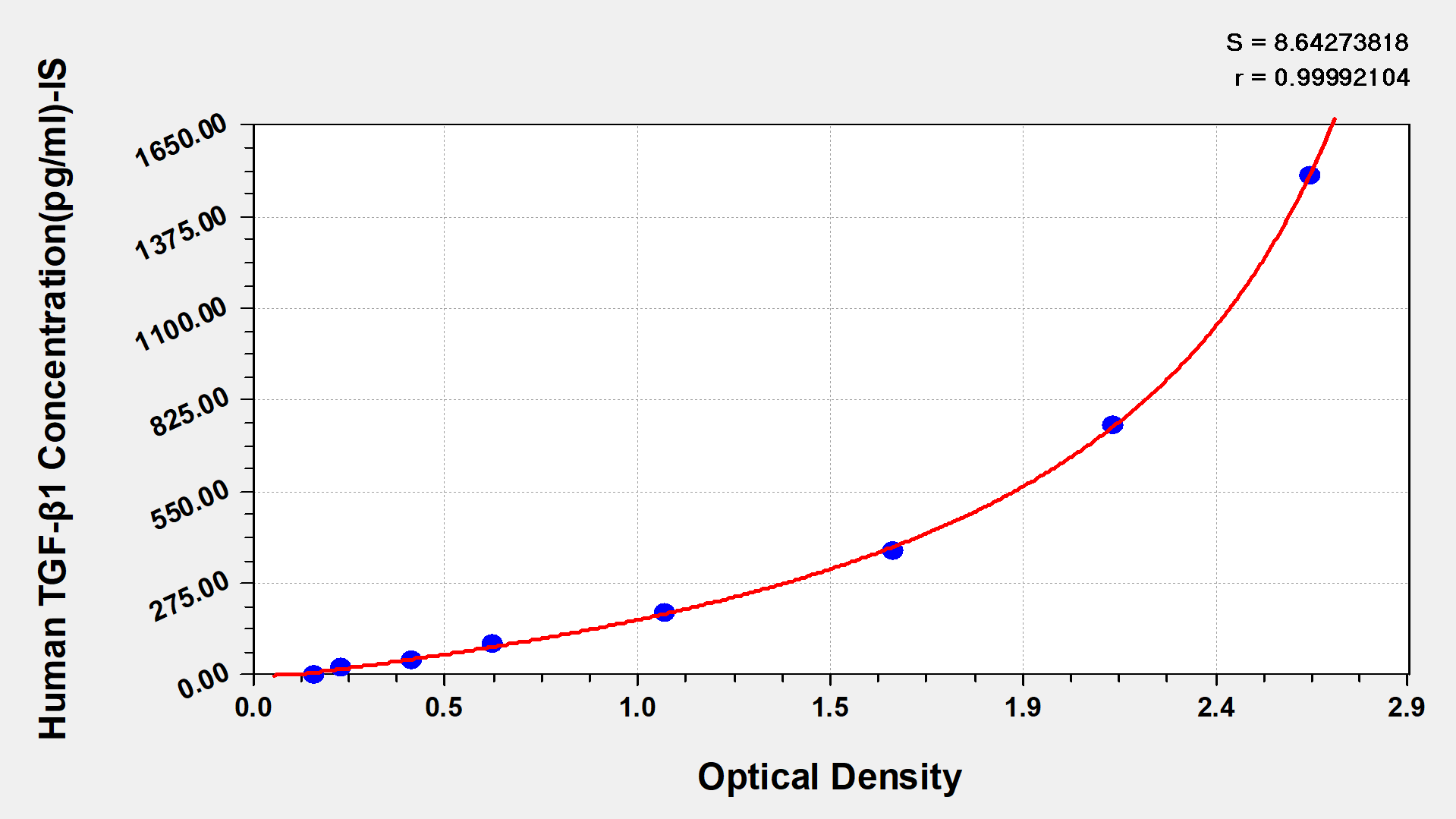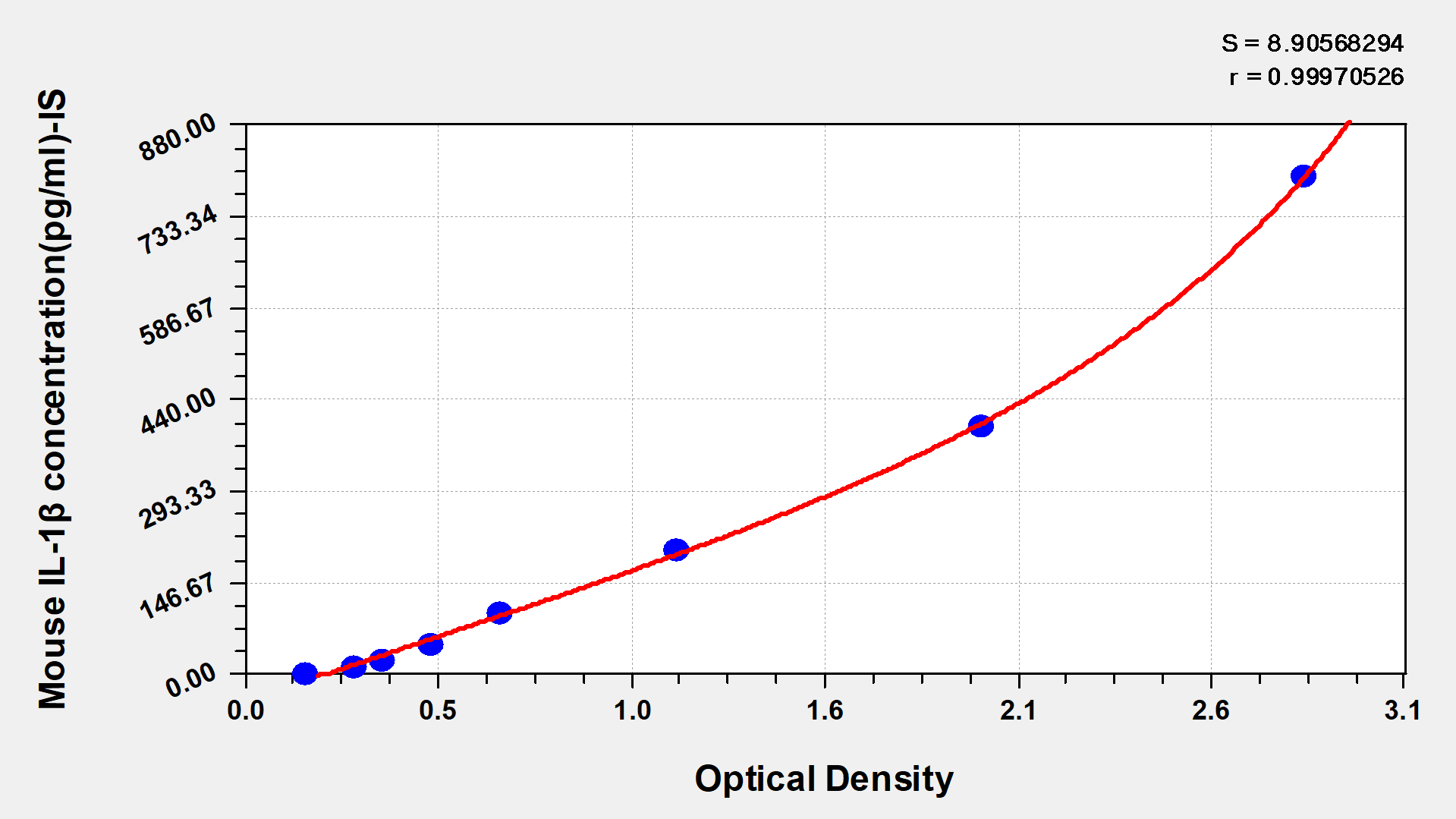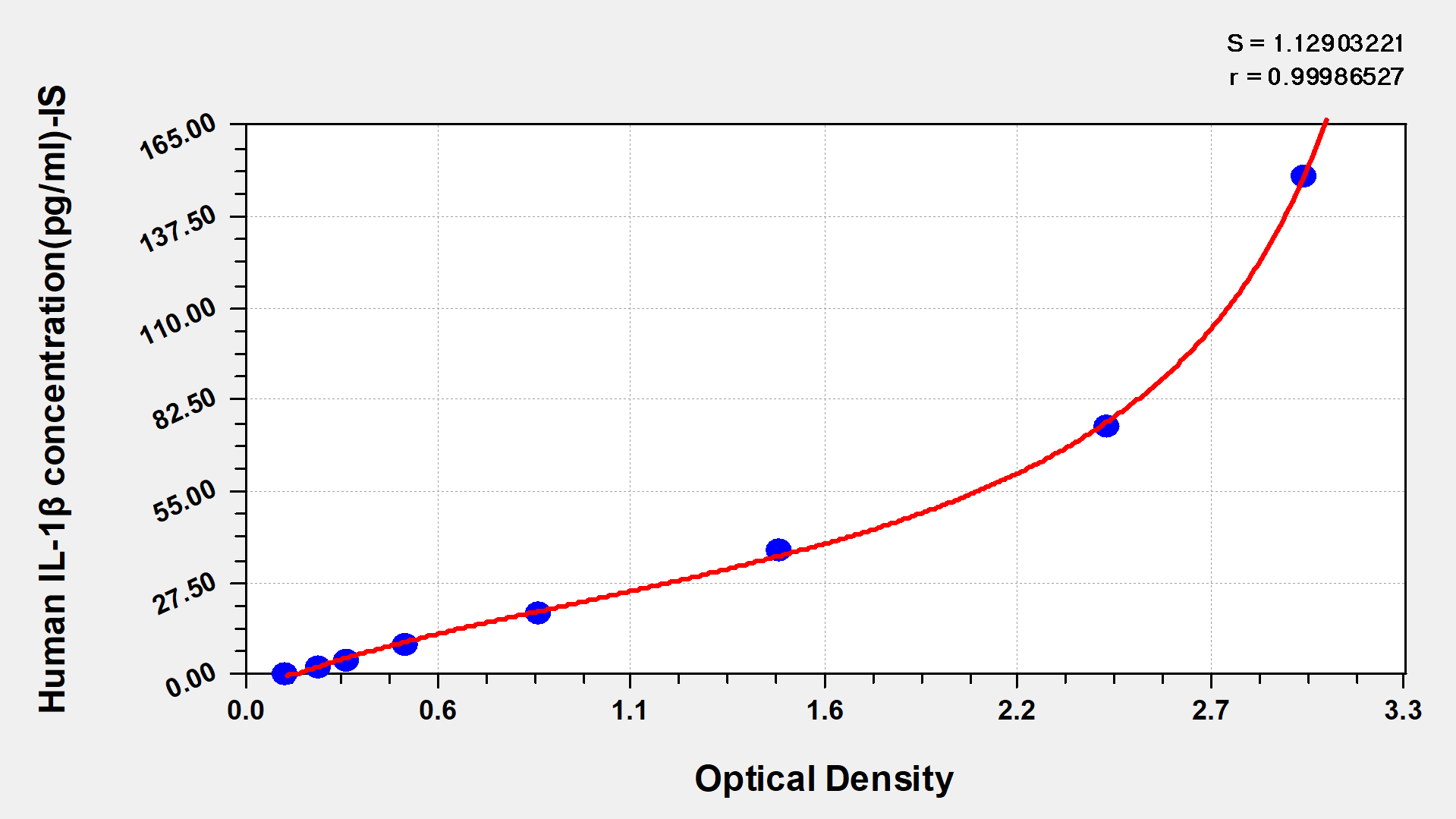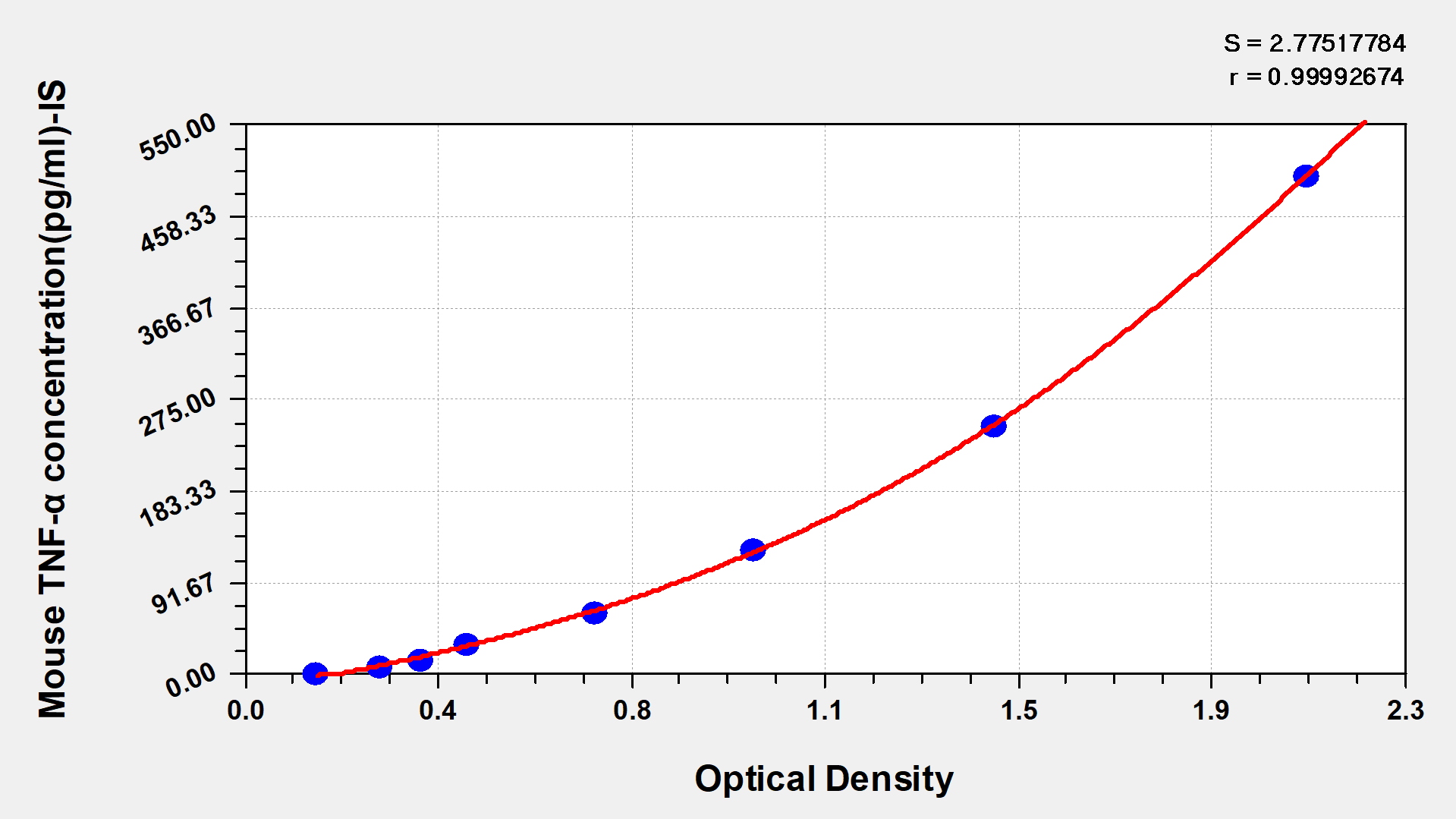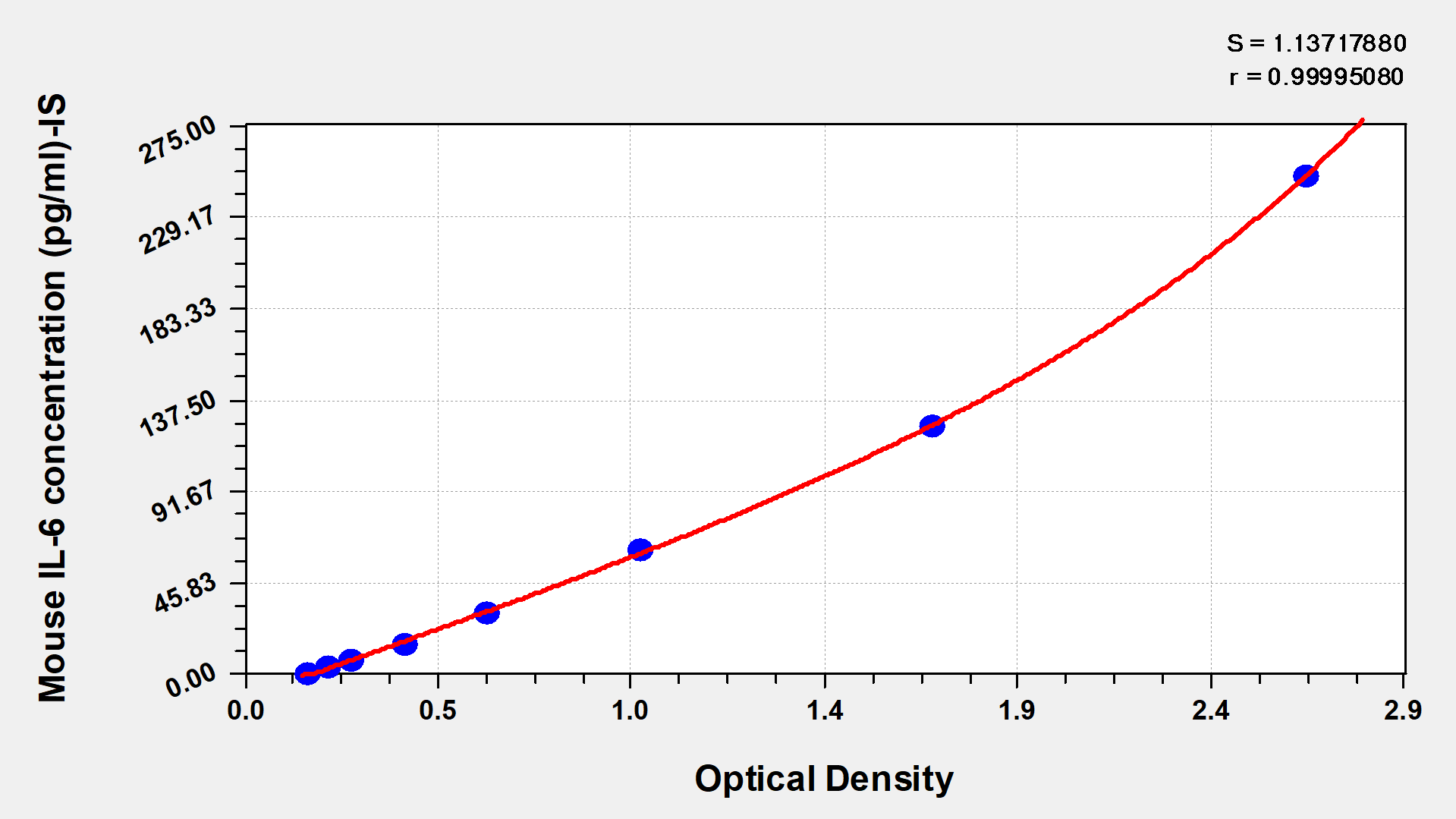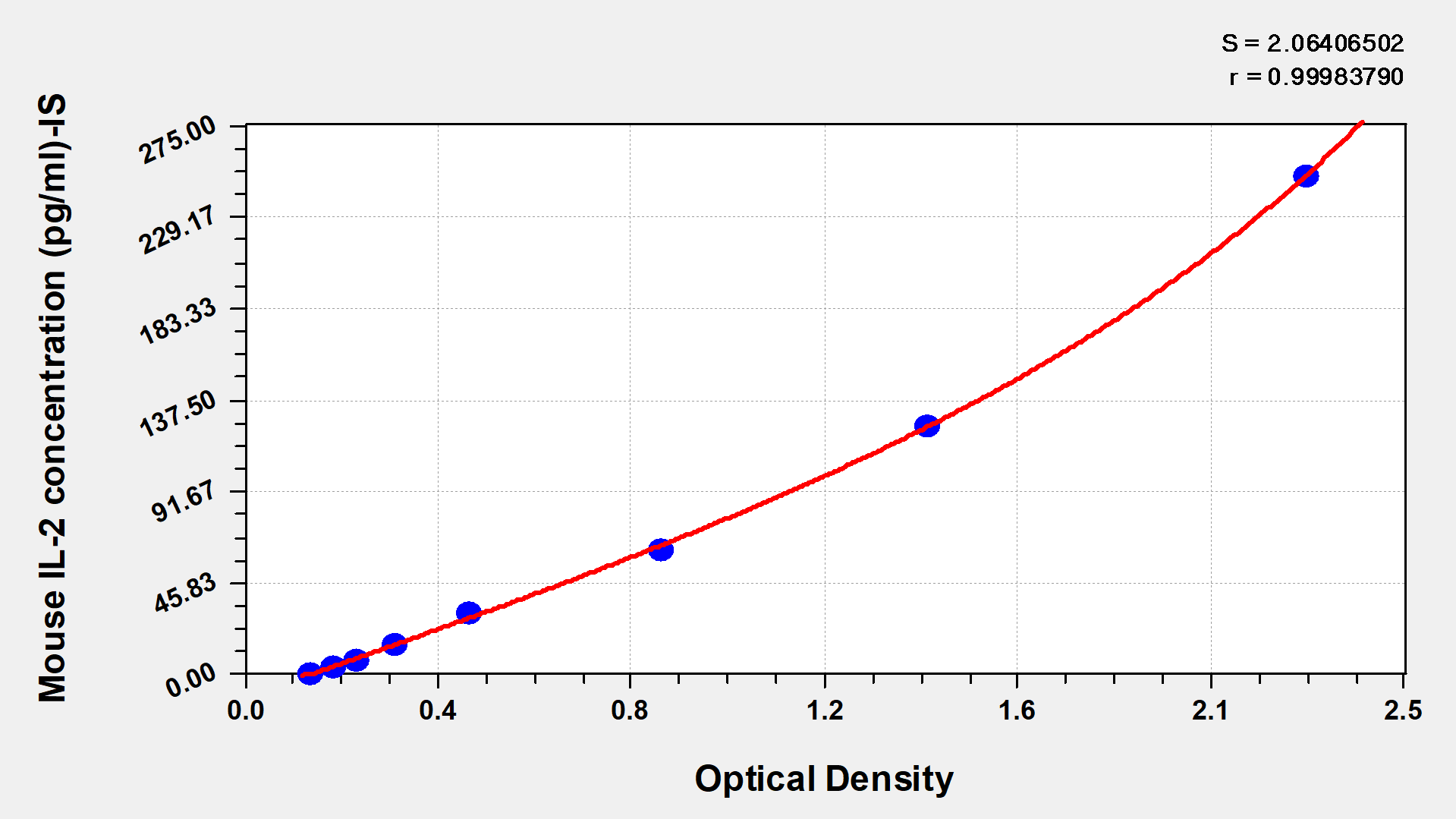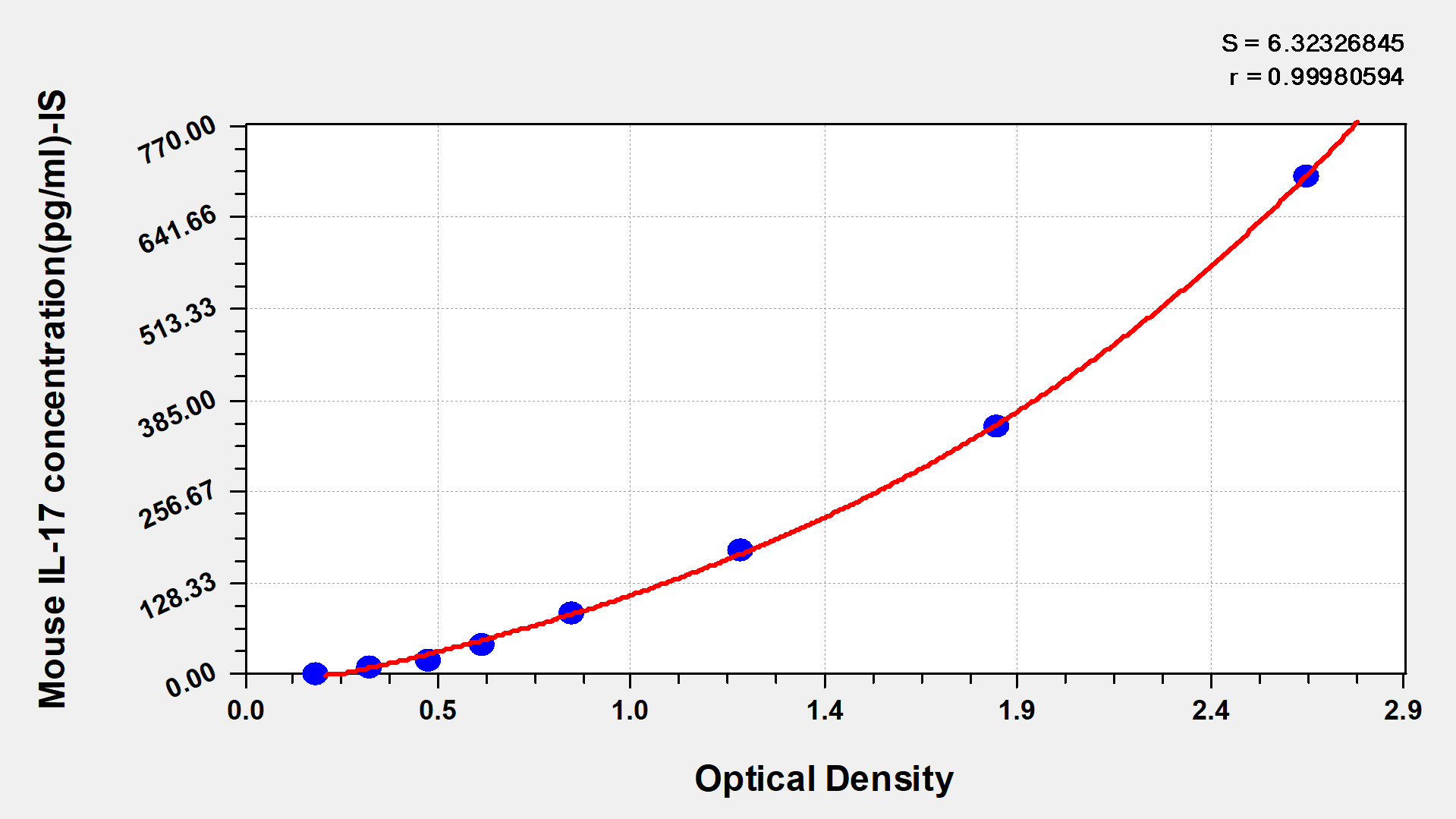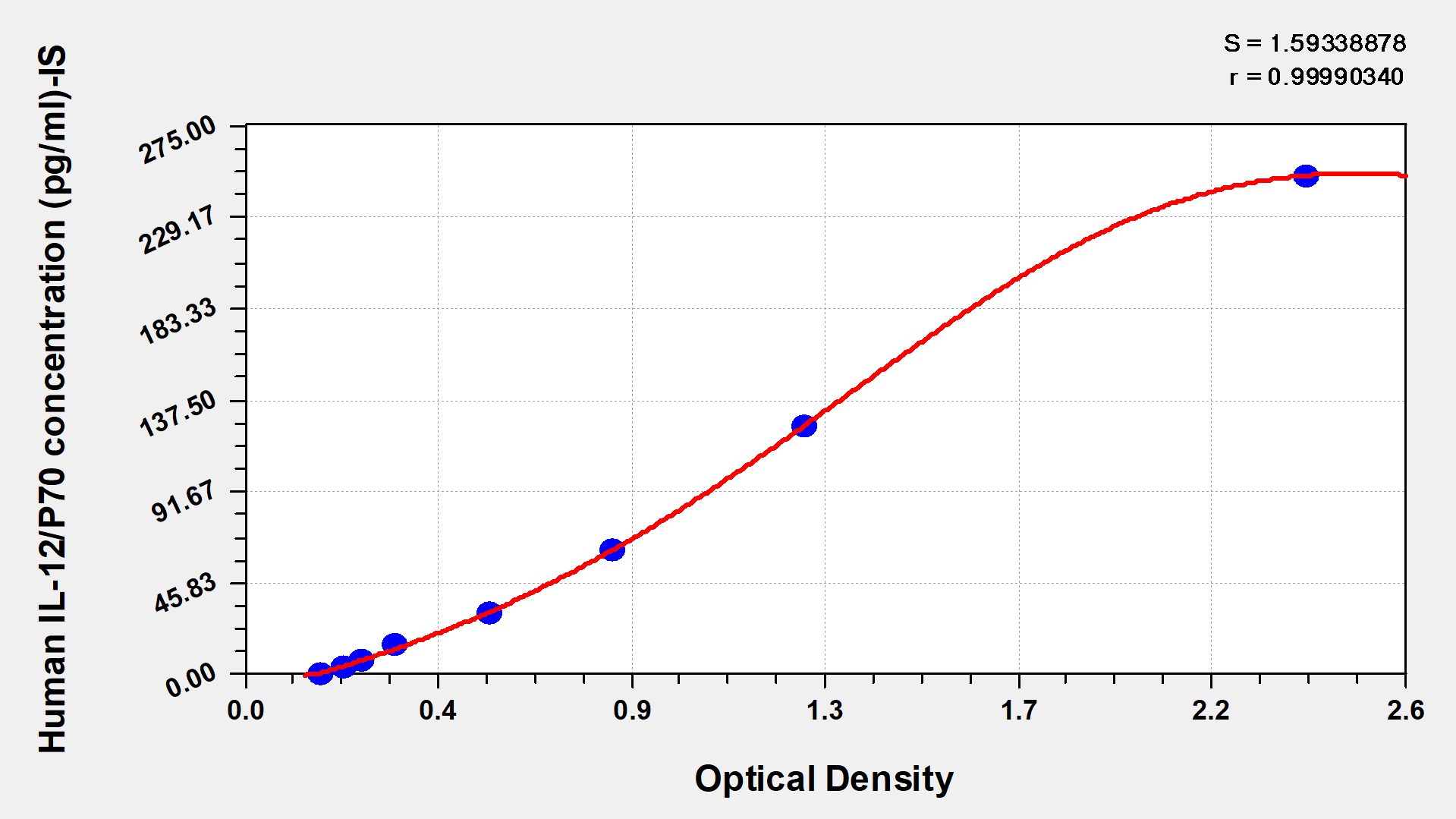-
中文名稱:小鼠C-X-C趨化因子9(CXCL9)酶聯免疫試劑盒
-
貨號:CSB-EL006252MO
-
規格:96T/48T
-
價格:¥3600/¥2500
-
其他:
產品詳情
-
產品描述:小鼠C-X-C趨化因子9(CXCL9)酶聯免疫試劑盒(CSB-EL006252MO)為雙抗夾心法ELISA試劑盒,定量檢測血清、血漿、組織勻漿樣本中的CXCL9含量。CXCL9是一個重要靶點。它屬于趨化因子家族,在免疫調節等生理病理過程中發揮作用。其研究機制主要圍繞與受體結合,招募免疫細胞,參與機體免疫反應,在腫瘤免疫、自身免疫病等領域是研究熱點,有望為相關疾病治療帶來新策略。試劑盒檢測范圍為15.6 pg/mL-1000 pg/mL,靈敏度為3.9 pg/mL。適用于感染性疾病模型、自身免疫疾病機制研究、腫瘤微環境分析等基礎科研領域,為探索免疫細胞趨化、免疫調控網絡及病理過程中CXCL9的動態變化提供可靠工具。本品僅用于科研,不用于臨床診斷,產品具體參數及操作步驟詳見產品說明書。
-
別名:Cxcl9 ELISA Kit; Mig ELISA Kit; Scyb9C-X-C motif chemokine 9 ELISA Kit; Gamma-interferon-induced monokine ELISA Kit; Monokine induced by interferon-gamma ELISA Kit; MIG ELISA Kit; MuMIG ELISA Kit; Protein m119 ELISA Kit; Small-inducible cytokine B9 ELISA Kit
-
縮寫:
-
Uniprot No.:
-
種屬:Mus musculus (Mouse)
-
樣本類型:serum, plasma, tissue homogenates
-
檢測范圍:15.6 pg/mL-1000 pg/mL
-
靈敏度:3.9 pg/mL
-
反應時間:1-5h
-
樣本體積:50-100ul
-
檢測波長:450 nm
-
研究領域:Immunology
-
測定原理:quantitative
-
測定方法:Sandwich
-
精密度:
Intra-assay Precision (Precision within an assay): CV%<8% Three samples of known concentration were tested twenty times on one plate to assess. Inter-assay Precision (Precision between assays): CV%<10% Three samples of known concentration were tested in twenty assays to assess. -
線性度:
To assess the linearity of the assay, samples were spiked with high concentrations of mouse CXCL9 in various matrices and diluted with the Sample Diluent to produce samples with values within the dynamic range of the assay. Sample Serum(n=4) 1:1 Average % 85 Range % 82-89 1:2 Average % 106 Range % 103-109 1:4 Average % 89 Range % 85-93 1:8 Average % 107 Range % 103-110 -
回收率:
The recovery of mouse CXCL9 spiked to levels throughout the range of the assay in various matrices was evaluated. Samples were diluted prior to assay as directed in the Sample Preparation section. Sample Type Average % Recovery Range Serum (n=5) 96 93-99 EDTA plasma (n=4) 102 98-106 -
標準曲線:
These standard curves are provided for demonstration only. A standard curve should be generated for each set of samples assayed. 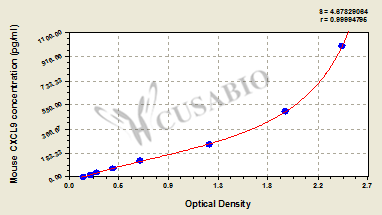
pg/ml OD1 OD2 Average Corrected 1000 2.445 2.401 2.423 2.287 500 1.938 1.905 1.922 1.786 250 1.206 1.301 1.254 1.118 125 0.667 0.609 0.638 0.502 62.5 0.405 0.394 0.400 0.264 31.2 0.256 0.258 0.257 0.121 15.6 0.209 0.201 0.205 0.069 0 0.137 0.134 0.136 -
數據處理:
-
貨期:3-5 working days
引用文獻
- Parabacteroides distasonis promotes CXCL9 secretion of tumor-associated macrophages and enhances CD8+T cell activity to trigger anti-tumor immunity against anti-PD-1 treatment in non-small cell lung cancer mice Z Fan, Z Yi, S Li, J He,BMC biotechnology,2025
- Endosialin-positive CAFs promote hepatocellular carcinoma progression by suppressing CD8+ T cell infiltration L Gan, T Lu, Y Lu, H Song, J Zhang, K Zhang,Journal for ImmunoTherapy of Cancer,2024
- Parishin alleviates vascular ageing in mice by upregulation of Klotho X Zhao,Journal of cellular and molecular medicine,2023
- Histone deacetylases inhibitor chidamide synergizes with humanized PD1 antibody to enhance T-cell chemokine expression and augment Ifn-γ response in NK-T cell lymphoma T Wen,EBioMedicine,2023
- The Chemokine Receptor CXCR3 Inhibits Autoimmune Cholangitis via CD8+ T Cells but Promotes Colitis via CD4+ T Cells Qing-Zhi Liu.et al,Front. Immunol.,2018
相關產品
靶點詳情
-
功能:May be a cytokine that affects the growth, movement, or activation state of cells that participate in immune and inflammatory response.
-
基因功能參考文獻:
- although the expression of CXCL9 and CXCL11 are increased after spinal nerve ligation, they may not contribute to the maintenance of neuropathic pain. PMID: 29712506
- Cxcl9 has a role in angiogenesis and osteogenesis in bone. PMID: 27966526
- Data suggest that the CXCL9-CXCR3 axis plays a pivotal role in the liver-specific distribution of TRAIL+ NK cells in mice. PMID: 29088306
- IFNalphaR1 signaling promoted CXCL9 and CXCL10 synthesis, suggesting that these chemokines might be involved in the LPS and CD134 costimulation response. PMID: 28432083
- CXCL10 plays in the pathogenesis of recurrent Herpetic stromal keratitis, and that CXCL9 displays its importance when CXCL10 is absent. PMID: 28282568
- CXCL9 expression is strongly upregulated in PGRN KO mice and its level is correlated with severity of inflammation in a dermatitis model. PMID: 26892362
- hepatic expression of the inflammatory CXC chemokine ligands (CXCL)9 and CXCL10 strongly increased whereas homeostatic CXCL12 significantly decreased. PMID: 26052942
- Here, we report the evidence for the production of MIG, a second CXCR3 ligand, during the primary immune response to HSV-1 corneal infection. PMID: 25207638
- These findings identify a novel role for the immune cell-derived CXCL9 chemokine in directing a protective antimicrobial response in the intestinal mucosa. PMID: 25643352
- These results indicate that CXCL9 is crucial for recruiting immune T cells into the brain and inducing an accumulation of the T cells into the areas where tachyzoites proliferate to prevent reactivation of chronic T. gondii infection. PMID: 25432064
- tumours are characterized by expression of inflammatory chemokines (CCL2, CCL5, CCL7, CCL8, CCL12, CXCL9, CXCL10 and CX3CL1), reflected by an enrichment of activated Foxp3(-) and Foxp3(+) T cells PMID: 25495686
- Aged mice had similar levels of IL-1beta, TNF, IFN-gamma, IL-17, and granulocyte colony-stimulating factor following S. pneumoniae infection, compared with young mice, but increased levels of the chemokines CXCL9, CXCL12, CCL3, CCL4, CCL5, CCL11, and CCL17. PMID: 25595646
- Data indicate that a feed-forward CXCL9-dependent circuit provided additional chemotactic cues that further increase local memory cell density. PMID: 23352234
- IFN-gamma-mediated loss of Mig expression in cutaneous tumors as a potent mechanism of immunoediting that results in increased tumor resistance to T cell-mediated immunity. PMID: 23241877
- CXCL9/10 have antifibrotic roles on liver non-parenchymal cells PMID: 22905138
- findings show that effector T cells cannot accumulate within the decidua, the specialized stromal tissue encapsulating the fetus and placenta; impaired accumulation was in part attributable to the epigenetic silencing of key T cell-attracting inflammatory chemokine genes in decidual stromal cells PMID: 22679098
- Mig contributes to the acute lethal toxicity arising from 5-FU administration. PMID: 22474250
- Cxcr3, Cxcl9 and Cxcl10 are increased in alopecia areata. PMID: 22358057
- The results identify direct angiostatic and antifibrotic effects of the Cxcr3 ligand Cxcl9 in a model of experimental liver fibrosis. PMID: 22237831
- MIG/CXCL9 is expressed in the lungs upon pneumococcal infection in a MyD88-dependent manner PMID: 20381636
- Expression of the chemokine Mig (CXCL9) was increased 2.8-fold in tumors from Egr-1 knockout mice. PMID: 19200397
- CXCL9 promotes the development of IFN-gamma-producing CD8 T cells, and CXCL10 antagonizes this skewing during allograft rejection. PMID: 20194716
- CCL2, CXCL9 and CXCL2 mRNA are up-regulated after oral Salmonella infection in Peyer's patches and lymph nodes coincident with the first arrival of monocytes and neutrophils PMID: 19839009
- MIG (CXCL9) chemokine gene therapy combines with antibody-cytokine fusion protein to suppress growth and dissemination of murine colon carcinoma. PMID: 11731434
- in study of relevance of chemokine expression to selective migration of t-cells and the disease localization in murine graft-versus-host disease, Mig was found to be predominantly expressed in spleen, liver, and not skin, and not heart. PMID: 12098066
- NF-kappaB has a critical role in mediating IFN-gamma-induced MIG (monokine induced by IFN-gamma) expression independent of hyaluronan PMID: 12226082
- involved in T cell cardiac allograft vasculopathy PMID: 12368204
- Data show that the transcriptional coactivator CREB-binding protein (CBP) mediated the STAT1/NF-kappaB synergy for transcription of the gene for CXC ligand 9 an interferon-gamma (IFN-gamma)-inducible chemokine. PMID: 12403783
- full potency of SLC/CCL21-mediated anti-tumor responses require in part the induction of IFNgamma, MIG/CXCL9 and IP-10/CXCL10 PMID: 12740040
- Peak of expression of CXCL9 and CXCL10 occurred 4 days before CD8+ T cells infiltrated infected tissues. CXCL9 and CXCL10 may play role early during immune response against rickettsial infections. PMID: 14507644
- Mig functions as a negative regulator of murine eosinophils PMID: 14769916
- exogenous CXCL9 stimulated CD4 lymphocyte proliferation in a MHC class II-mismatched MLR and increased the number of IFN-gamma-producing CD4 lymphocytes PMID: 15187119
- Interactions involving CXCR3 and its primary ligands Mig and IP-10 significantly contribute to donor T cell recruitment to the lung after allogeneic stem cell transplantation. PMID: 15265940
- RANKL stimulates the serine phosphorylation of STAT1, causing MIG gene transcription and secretion, which may have a role in recruiting CXCR3-positive osteoclast precursors and osteoclasts to bone remodeling or inflammatory sites. PMID: 15585657
- IFN-gamma knockout mice, which manifested depressed ear-swelling following delayed hypersensitsivity challenge, made no Mig. PMID: 15629884
- Results suggest that in the sensitized host, CXCR3, IP-10, and Mig are required for optimal delayed hypersensitivity responsiveness but are not essential for containing HSV-1 replication. PMID: 15708587
- results suggest that MUM1 plays roles in the progression of B-cell lymphoma/leukemia by regulating the expression of various genes including MIG. PMID: 15959530
- CXCL9 has a role in graft rejection in the absence of CCL19 and CCL21 PMID: 16095489
- MIG mRNA expression in the lungs of Klebsiella-infected mice requires the endogenous production of IFN-gamma. PMID: 16299319
- CXCL9 signaling enhances immune responses following Trypanosoma cruzi infection; transcripts for CXCL9 remain elevated during chronic infection PMID: 16368965
- CXCL9 is up-regulated in unique patterns following tracheal transplantation in mice. Deletion of CXCL9 does not affect airway obliteration. PMID: 16709871
- These results suggest that the more aggressive rejection of xenografts compared with allografts is due to the earlier expression of CXC-chemokines, IP-10 and MIG, and subsequent adjuvant effects of proinflammatory cytokines. PMID: 16768726
- Collectively, the results suggest a non-redundant role for CXCL9 and CXCL10 in response to ocular HSV-1 infection in terms of controlling virus replication and recruitment of CD4(+) T cells into the cornea. PMID: 17296171
- Acute ethanol intoxication impairs lung expression of Cxcl9, interfering with pulmonary response to bacterial challenge. PMID: 17889309
- IFN-gamma is mediator of Cxcl10 and Cxcl9 gene expression in experimental autoimmune encephalomyelitis(EAE). It differentially regulates expression of these genes by astrocytes and microglia. Differential glial localization of these chemokines in EAE. PMID: 17902170
- The absence of CXCL9 or CXCL10 expression significantly alters the ability of the host to control genital HSV-2 infection through the mobilization of effector cells to sites of infection. PMID: 18178850
- These data demonstrate that CXCR3 on CD8(+) T cells is required for T cell recruitment into the brain and the development of murine cerebral malaria. PMID: 18347328
- Liver sinusoidal endothelial cells present chemokines (CXCL12 and CXCL9) to circulating lymphocytes. PMID: 18697212
- CXCR3 ligands, IP10 and MIG, contribute to Th1-induced inflammation but not to homing of Th1 cells into the lung. PMID: 18716926
- CXCL9 promotes protection from coronavirus-induced neurological and liver disease. PMID: 18973912
顯示更多
收起更多
-
亞細胞定位:Secreted.
-
蛋白家族:Intercrine alpha (chemokine CxC) family
-
數據庫鏈接:
Most popular with customers
-
Human Transforming Growth factor β1,TGF-β1 ELISA kit
Detect Range: 23.5 pg/ml-1500 pg/ml
Sensitivity: 5.8 pg/ml
-
-
-
Mouse Tumor necrosis factor α,TNF-α ELISA Kit
Detect Range: 7.8 pg/ml-500 pg/ml
Sensitivity: 1.95 pg/ml
-
-
-
-



